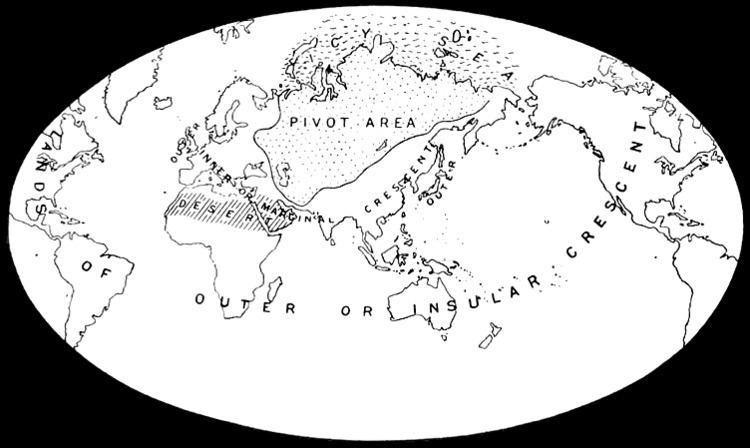 | ||
The Geographical Pivot of History, sometimes simply as The Pivot of History is a geostrategic theory, also known as Heartland Theory. "The Geographical Pivot of History" was an article submitted by Halford John Mackinder in 1904 to the Royal Geographical Society that advanced his Heartland Theory. In this article, Mackinder extended the scope of geopolitical analysis to encompass the entire globe.
Contents
The World-Island and the Heartland
According to Mackinder, the Earth's land surface was divisible into:
The Heartland lay at the centre of the world island, stretching from the Volga to the Yangtze and from the Himalayas to the Arctic. Mackinder's Heartland was the area then ruled by the Russian Empire and after that by the Soviet Union, minus the Kamchatka Peninsula region, which is located in the easternmost part of Russia, near the Aleutian Islands and Kurile islands.
Strategic importance of Eastern Europe
Later, in 1919, Mackinder summarised his theory as:
Any power which controlled the World-Island would control well over 50% of the world's resources. The Heartland's size and central position made it the key to controlling the World-Island.
The vital question was how to secure control for the Heartland. This question may seem pointless, since in 1904 the Russian Empire had ruled most of the area from the Volga to Eastern Siberia for centuries. But throughout the nineteenth century:
Mackinder held that effective political domination of the Heartland by a single power had been unattainable in the past because:
He outlined the following ways in which the Heartland might become a springboard for global domination in the twentieth century (Sempa, 2000):
The combined empire's large East Asian coastline would also provide the potential for it to become a major sea power. Mackinder's "Who rules East Europe commands the Heartland ..." does not cover this scenario, probably because the previous 2 scenarios were seen as the major risks of the nineteenth century and the early 1900s.
One of Mackinder's personal objectives was to warn Britain that its traditional reliance on sea power would become a weakness as improved land transport opened up the Heartland for invasion and / or industrialisation (Sempa, 2000).
In the Western powers
Mackinder identified the geopolitical nightmare that was to haunt the world's two sea powers during the first half of the twentieth century—Great Britain and, later on, the United States. The nightmare was that if Germany or Russia were allowed to control East Europe then this could lead to the domination of the Eurasian land mass by one of these two powers as a prelude to mastery of the world.
Influence of the theory on other geopolitical models
Signs of Mackinder's Heartland Theory can be found in the works of geopolitician Dimitri Kitsikis, particularly in his "Intermediate Region" model. There is a significant geographical overlap between the Heartland or "Pivot Area" and the Intermediate Region, with the exception of Germany-Prussia and north-eastern China, which Kitsikis excludes from the Intermediate Region. Mackinder, on the other hand, excludes North Africa, Eastern Europe and the Middle East from the Heartland. The reason for this difference is that Mackinder's model is primarily geo-strategic, while Kitsikis' model is geo-civilizational. However, the roles of both the Intermediate Region and the Heartland are regarded by their respective authors as being pivotal in the shaping of world history.
Criticism
K. S. Gadzhev, in his book Vvedenie v geopolitiku (Introduction to Geopolitics) raises a series of objections to Mackinder's Heartland to start with that the significance physiography is given there for political strategy is a form of geographical determinism.
